A French-Ukrainian political scientist and writer, Maryna Kumeda, recently returned to her hometown of Sumy, near the Russian border, where the Ukrainian military launched a surprise operation in the Kursk region on August 6. In her account, she details the daily struggles of residents living under relentless shelling.
As the Kyiv-Sumy train makes its second stop, a man steps into our compartment, apologising for the plastic bags he carries and expressing his delight at travelling with women. He mentions his “injured leg,” which makes movement a bit difficult, he explains, before climbing into the upper bunk to sleep, muttering softly to himself. After a while, he wakes up, descends from the bunk, and accepts my phone charger with a grateful nod. He begins conversing in Russian, revealing that he hails from near Pokrovsk in the Donbas, a city currently under Russian assault. His casual demeanour contrasts with the weight of his circumstances, providing a glimpse into the lives of those affected by the ongoing war.
The man was wounded in the Kursk region of Russia just several weeks ago: “I dreamed of travelling abroad, but I never expected it to happen this way. I was fortunate; I was evacuated almost immediately. Three people and a car risked their lives to come and get me while chaos erupted around us.” He finally agrees to a coffee.
Mykola hasn’t seen his children in twelve years due to a difficult divorce. Recently, his daughter told him over the phone that she loved him, bringing him to tears in front of his comrades. “Children are such a blessing. It’s a pity I couldn’t have any with my second wife.” He voluntarily enlisted in the army and signed a contract “until the end of the war,” he says with a wry smile.
“I was fortunate this time with a minor injury, but I’m not sure I’ll make it to forty,” he reflects. “In that second hospital, everything felt reminiscent of the Soviet era; I hadn’t encountered such a strong chlorine smell in ages. Back in school, I avoided the toilets because of that scent—I’d go behind the school instead.”
“Is this already Sumy?” he suddenly exclaims, jumping up. I ask him where he’s heading in Sumy. “To the trenches,” he replies with a wistful smile.
Approximately thirty kilometres from the Russian border, Sumy, where the Ukrainian army launched a surprise incursion into the Kursk region on August 6, remains on high alert. Once home to around 260,000 residents, the city is still grappling with its scars. Memories of the region’s occupation by Russian forces during the march on Kyiv in February 2022 are fresh, marked by fierce resistance from territorial defence units and civilians who felt abandoned by local authorities. Since the summer of 2023, Russian strikes against the city have intensified, becoming a daily reality in nearby border villages.
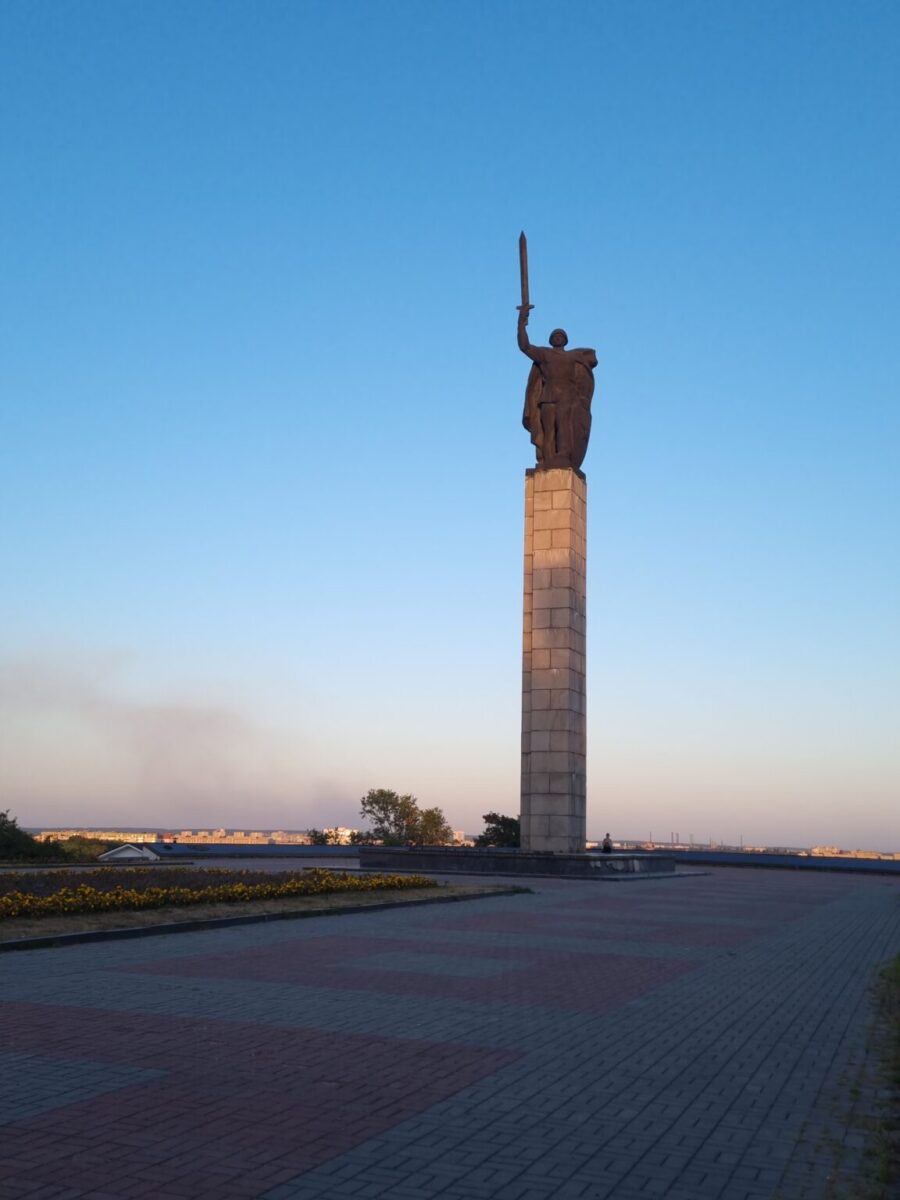
Memorial to Eternal Glory. Photo: Maryna Kumeda.
The threat of a counteroffensive in the Sumy region emerged in May, following similar actions in Kharkiv. Daily conversations revolve around news of strikes in neighbouring villages, fostering a climate of caution among residents. Since Ukraine’s incursion into Russia, there has been an uptick in military activity, with planes, helicopters, and armoured vehicles increasingly visible. Over recent months, sabotage and reconnaissance groups have crossed from Russian territory, sometimes resulting in civilian casualties—14 reported in 2023—while military death tolls remain undisclosed.
Since the beginning of 2024, the Sumy region has endured 11,000 strikes, starkly higher than the 8,000 recorded throughout all of 2023, resulting in the deaths of 85 civilians. The arsenal employed includes Shahed drones priced at €18,000, aviation bombs at €30,000, and Iskander missiles costing €2.7 million, alongside mortars, grenade launchers, and FPV drones—indicating a comprehensive utilisation of available munitions.
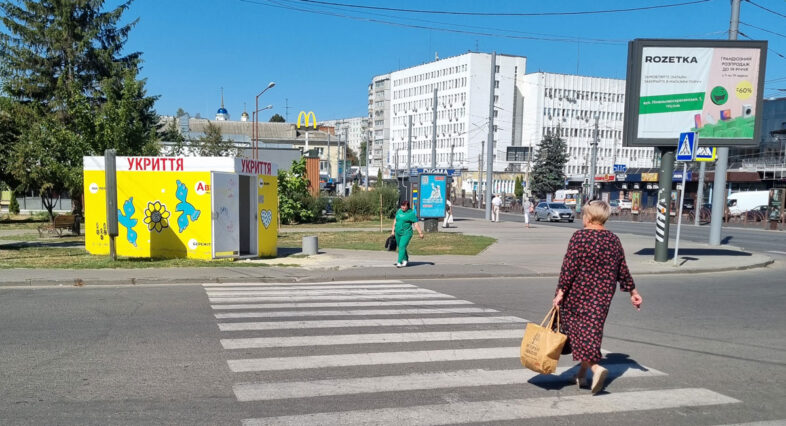
Shelter set up in downtown Sumy. Photo: Maryna Kumeda.
On Sunday, September 8, as many Ukrainians tended to their gardens and country homes, a bombing in Sumy injured four people, while an elderly couple tragically lost their lives. According to the city council, thirty-two buildings and five vehicles sustained damage, with essential water and electricity networks destroyed. That same day, following an attack on the village of Stetskivka, two individuals were hospitalised—one in critical condition in intensive care and a 14-year-old in stable condition. The assault also claimed the life of a dog, and damage was reported to an administrative building, a shop, eight homes, and a vehicle. Yuriy Lysenko, the mayor of this town with a population of 3,800, located 15 kilometres north of Sumy, informed the local TV channel Suspilne that the town hall and seven other structures were also impacted.
According to the Ministry of Internal Affairs, 45,000 individuals, including 5,000 children, are set to be evacuated from the Sumy region, with volunteers from the national police and the state emergency service appointed to oversee the operation. Initially, a 5-kilometre-wide evacuation zone was established in the summer of 2023, but this was expanded to 10 kilometres in May 2024. The Ukrainian incursion into Russia has been framed as a necessary measure to secure a border area that has faced frequent attacks.
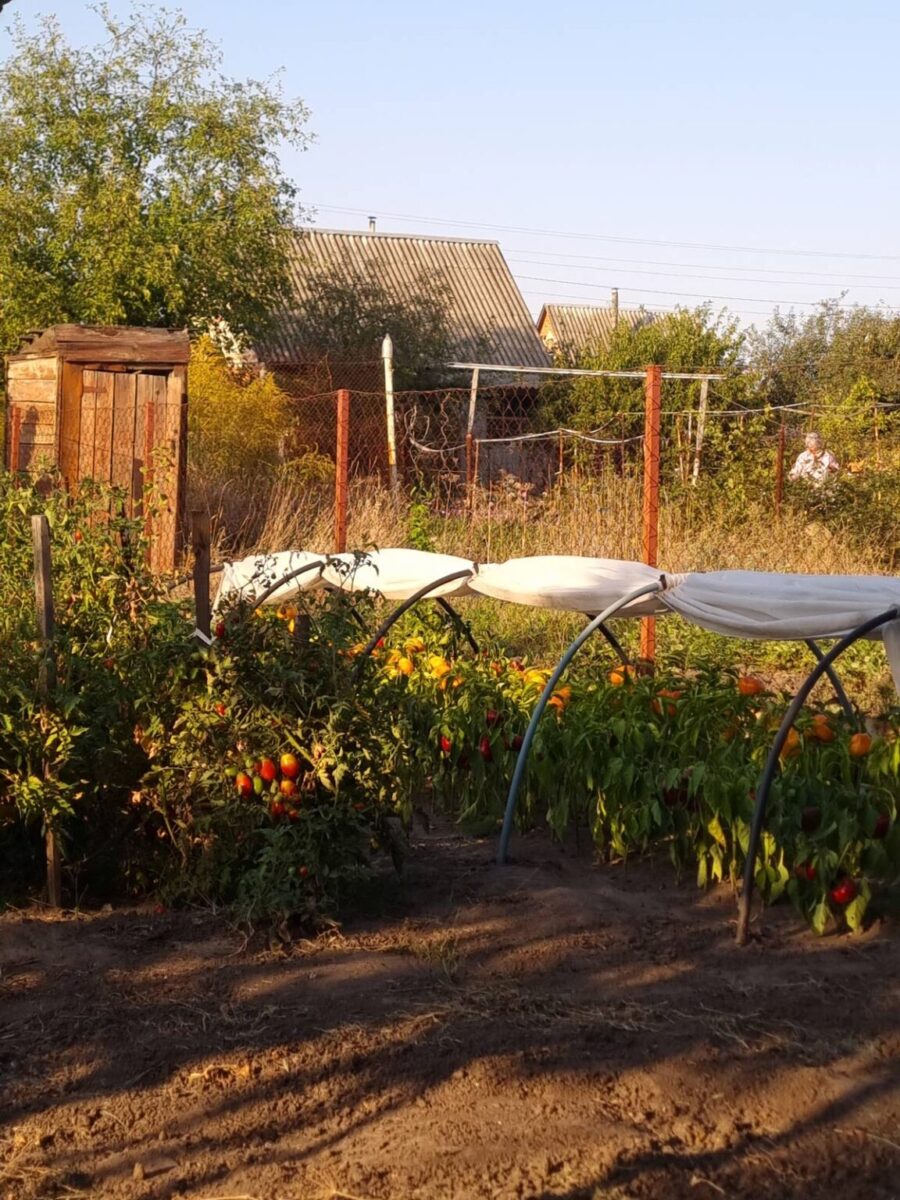
Harvest season. Photo: Maryna Kumeda.
Despite the ongoing threat of intense combat and regular strikes, life in the region has not ground to a halt. Soybean harvesting continues unabated on weekends, and local cafés are bustling in the mornings with coffee enthusiasts relishing high-quality roasted beans and freshly baked pastries. Outside the Bilyi Nalyv cider bar, a group of young people can be seen laughing as they prepare to enjoy pizzas.
At the rooftop Dakh [“A roof” in Ukrainian – ed.], young women capture selfies against a backdrop of city rooftops, the cathedral dome, and Soborna Street, while nearby, a group of men in their forties savours beer accompanied by shisha, seamlessly blending moments of normalcy amid the turmoil.
However, daily changes are evident. The Krasnopillia-Sumy train service has been suspended since September 3, aimed at safeguarding the lives of railway employees and passengers. Additionally, the small street market, once bustling with vendors selling fish and sour cream directly from the ground, has dwindled, reliant on trains that previously arrived at Sumy station. Military vehicles, which could indicate potential Russian strikes or become targets for arson by saboteurs hired for a few hundred dollars, have largely vanished from the city’s streets. On September 4, the Defence Council expanded the evacuation list to include Hlukhiv, Esman, and Svesa in the Shostka district, as well as Manukhivka and Ivanivka in the Konotop district.
Military vehicles now speed along nearby roads, and the network of trenches, bunkers, fortifications, and dragon’s teeth has become increasingly prominent, accompanied by active checkpoints around the city. A tank, draped in an anti-drone net, tows a damaged off-road vehicle toward the forest’s edge. Yet, soldiers stationed at the checkpoint maintain a surprisingly relaxed demeanour.
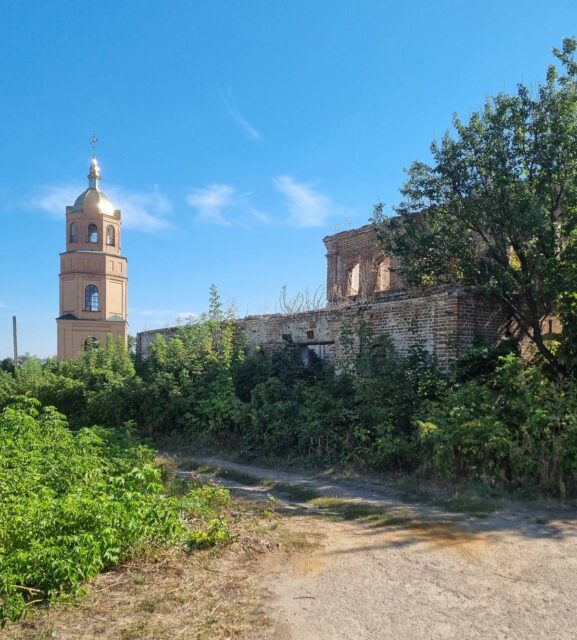
Abandoned Teremok and the renovated bell tower. Photo: Maryna Kumeda.
In Stare Selo [the “Old Village”], formerly known as Chervone Selo [the “Red Village”] until 2016, a new supermarket has recently opened its doors, joining a handful of other grocery stores in the area.
In the village, tales abound regarding daily life in the region, including the mayor of the neighbouring village of Nyzy, who takes pride in his Tesla, valued at approximately €40,000, and is open about it. Nyzy was once favoured by composer Pyotr Tchaikovsky, who spent several summers there with his close friend and lover, drawing inspiration from local traditional motifs that influenced his musical compositions.
Stare Selo is particularly proud of Teremok, the oldest manor in the region, constructed in 1753 by Colonel Kondratiev, a descendant of Sumy’s founder, Gerasim Kondratiev. In the 17th century, Kondratiev played a pivotal role in the settlement of Cossacks from the right bank of the Dnipro following their defeat by the Polish-Lithuanian Commonwealth and the subsequent repressions.
Nearby stands St. Nicholas Church, erected around the same period and destroyed during Soviet rule. Its bell tower has been restored, though not always with a faithful adherence to its original style, during the presidency of Viktor Yushchenko, who hails from this region. Behind the church lies the neo-Gothic Zboromirski Palace, built in the early 19th century. Once a school, it was abandoned in the 1980s after a new institution opened across the street and now stands in ruins.
With the war still ongoing, the community awaits a time of peace to commence restoration efforts and new projects, all within a mere 30 kilometres of the Russian border.
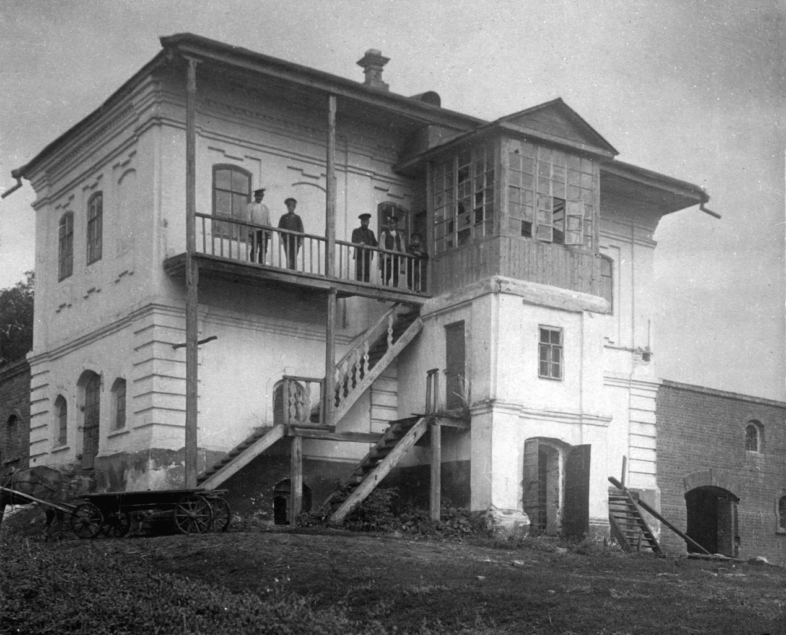
Teremok, in 1919 (source: Wikipedia).

